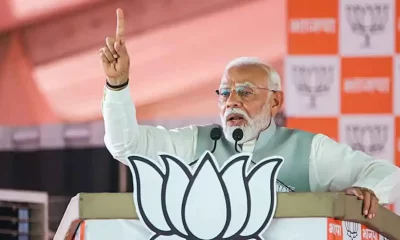Gadgets
Indian scientists at Pune’s NIV detect new strain of dengue virus

[vc_row][vc_column][vc_column_text]~By Dr T V Venkateswaran
Study by National Institute of Virology scientists shows that a dengue strain that originated in Singapore had emerged in Tamil Nadu in 2012 and Kerala in 2013
New Delhi: Scientists at Pune-based National Institute of Virology (NIV) have found a new genotype of dengue virus in patients who suffered due to one of the worst epidemics in recent years in Tamil Nadu. The study shows that the strain originated in Singapore and emerged in Tamil Nadu in 2012 and Kerala in 2013.
Even a single cell bacterium has not only DNA but also cell organelles. But viruses are just bits of DNA material in a wrap, and they use cellular mechanism of the host to multiply themselves. In doing so they damage the infected cells. The immune system of the body responds with production of specific antibodies, which destroy specific viruses.
Dengue virus comes in different types and each with different flavours. There are four serotypes of dengue virus – DENV-1 to 4. Each of them has multiple genotypes. The genotype variation can be subtle either in DNA material or the envelope. For example, DENV-1 comes in as many as five genotypes – Asia, South Pacific, Thailand, Malaysia and AM/AF.
When infected first time, the patient developed a life time immunity for that particular serotype due to presence of antibodies produced earlier. However, if the secondary infection is by another serotype, the immune system is confused and the infection can become life threatening.
“Dengue virus has four antigenically defined serotypes and each serotype has multiple genotypes with several clades based on phylogenetic analysis of envelope or whole genome sequences” says D Cecilia of the Dengue Group at ICMR-National Institute of Virology, Pune, who is the lead author of the new study. This makes developing an effective vaccine a major challenge.
During the last five years, the National Vector Borne Disease Control Programme (NVBDCP) reported 80,725 cases of dengue per year with a fatality rate of about 0.24%. The ten year data for Tamil Nadu, 2007–2016 show an average of 2539 cases per year with fatality of 0.21%. This is less than the national average. However, during 2012 the cases spiked to 12,826 and deaths rose to 66, which implied fatality of 0.51%. This was a clear signature of a dengue epidemic. Epidemiological studies indicated that Tirunelveli in Tamil Nadu was the epicentre of the epidemic.
Past research had shown that the emergence of new genotype was the cause of the major dengue outbreak in late 1980s in India. Taking a cue, scientists led by Dr Cecilia collected blood samples from patients in South India during the 2012 outbreak with the help of Vellore-based Christian Medical College. The genome sequence of the virus collected from the samples were compared against the GenBank library which hosts all known dengue virus samples from 1943 to 2015.
The study revealed that DENV-1 Asian genotype had replaced the AF-AM type that was hitherto dominant in Tamil Nadu. “All four serotypes were circulating but DENV-1 was dominant, present in 52% of the serotyped samples” says Cecilia. Further, the study showed that the DENV-1 Asian genotype had also developed a new phenotype in the E gene. “This is the first time after 20 years we are observing change in genotype in India,” the scientist added.
DENV-1 originated in US and Japan during 1932. However, the Asian genotype of DENV-1 that emerged in Thailand. The Indian strains that caused havoc during the 2012-15 emerged in Singapore sometime in 2005. The same strain caused an epidemic in Singapore in 2005 and later in 2009 in Sri Lanka. “Phylogenetic analysis revealed that the Asian genotype was introduced from Singapore and shared 99% similarity with viruses, associated with large outbreaks in Singapore and Sri Lanka. The movement of DENV can affect dengue outbreaks and underscores the need for close molecular monitoring of DENV,” says Cecilia.
The findings are published in journal Virology. The research team included D. Cecilia, J.A. Patil, M.B. Kakade, A. Walimbe, K. Alagarasu, B. Anukumar, from National Institute of Virology and A. Abraham from Christian Medical College, Vellore.
(This article has not been edited by the APNLive staff. It is auto-generated from a syndicated feed provided by the India Science Wire)[/vc_column_text][/vc_column][/vc_row]
Gadgets
WhatsApp to introduce Native File Sharing feature similar to Apple’s AirDrop
Users can choose to be visible to others without disclosing their phone numbers to people who are not their contacts.

A Meta-owned messaging platform, WhatsApp is all set to introduce a new feature that allows Android users to share files with another user nearby. According to reports, the feature will be developed similar to Apple’s AirDrop.
The file sharing feature nearby is not currently available for beta testers. However, according to a report from WhatsApp feature tracker WABetaInfo, it seems that the feature will soon be introduced. The report reveals a screenshot that shows an option within the app stating, to share files with people nearby, along with a list of nearby users.
It is interesting to note that users can choose to be visible to others without disclosing their phone numbers to people who are not their contacts. In order to share files with other users, one needs to wait for nearby users to accept their request. The process involves a unique interaction, where nearby users can shake their device to receive incoming share requests. It is important to note that this feature is designed with end-to-end encryption to ensure user privacy.
In the upcoming update, WhatsApp is expected to introduce a nearby file-sharing feature. However, the current beta version for Android, which is 2.24.2.20, has addressed a camera issue. Some Android beta testers have reported difficulties in launching the camera within the app after the 2.24.2.13 update. Upon launching, users were presented with an error message that said, can’t start camera, please restart your device. This issue persisted even after restarting the device or relaunching the app.
The latest beta update of WhatsApp, located at 2.24.2.20, has fixed the camera bug. This allows users to launch the camera within the app and share photos and videos with their contacts without any interruptions. As WhatsApp continues its efforts to improve its features and address bugs, users can expect a better messaging experience on the platform.
Gadgets
Meesho mega blockbuster sale: E-commerce platform to offer 80 percent discount on electronics
The e-commerce platform’s first mega blockbuster sale will sell more than 400 brands directly with the help of authorised partners on its digital store called Meesho Mall.

Ahead of the festive season, e-commerce platform Meesho’s mega blockbuster sale is starting on Friday, October 6, 2023. The platform will provide a massive discount of up to 80 percent on different categories such as essentials, accessories, electronics, footwear, etc.
The blockbuster sale is scheduled to conclude on October 13, 2023. Notably, the Softbank backed e-commerce platform is starting its festive sale a day before Flipkart or Amazon’s festive sale goes live. The e-commerce platform’s first mega blockbuster sale will sell more than 400 brands directly with the help of authorised partners on its digital store called Meesho Mall.
Reportedly, the platform also added over 50 lakh new customers during these sales. More than 75 percent of the demand was received from Tier-II cities, including Amravati, Aurangabad, Dehradun, Nellore, Solapur, and Warangal. The platform further claimed that they have added more than 2 lakh sellers in the past two years.
Recently, Meesho affirmed that they have received over 10 million (approx) from its pre-festive sales during Onam, Raksha Bandhan, and Ganesh Chaturthi. The platform has more than 14 lakh sellers, selling approx 12 crore products in 30 different categories.
In an effort to increase the seller base, the company announced the onboarding of non-GST sellers on the platform earlier this week. The GST council announced to permit the e-commerce platform to onboard sellers with turnover of up to Rs 40 lakh.
Prior to Meesho’s Mega Blockbuster Sale, the company introduced a loyalty programme during which eligible users will earn Smart Coins, which the user can redeem every time they make the purchase of any products on the platform.
As per Redseer, over 140 million shoppers are likely to make purchases during the festive season. This will enhance the Gross Merchandise Value (GMV) of the Indian e-commerce sector by 18 to 20 per cent and may touch Rs 90,000 crore as compared to Rs 76,000 crore last year.
Phones & gadgets
Apple launches iPhone 15 series, India price, features, availability
The iPhone 15 series will be available in India from September 22 but iPhone lovers can also pre-order, starting from September 15 onwards.

Apple launched its most anticipated iPhone 15 series, including the iPhone 15, iPhone 15 Plus, iPhone 15 Pro and iPhone 15 Pro Max during the Wonderlust event globally on September 12 night.
The iPhone 15 series will be available in India from September 22 but iPhone lovers can also pre-order, starting from September 15 onwards.
People can buy a new iPhone 15 or upgrade it to the old one. There are five colours available for the people.
According to reports, Apple has been manufacturing the iPhone 15 series in India and China. Apple has moved 7% of its iPhone production to India. Previously, India was not making the newest models. The Centre’s production-linked incentive (PLI) scheme for smartphones played a part in Apple moving its production to India.
The new iPhone 15 has been launched with the same starting price as its prototype, the iPhone 14. The 128GB variant is priced at Rs 79,900, while the 256GB variant costs Rs 89,900. For people who need more storage, the 512GB variant is available for Rs 1,09,900.
This latest iPhone series puffs a 6.1-inch display and comes in five different colours which are pink, yellow, green, blue, and black. While the design remains the same as the previous models, the iPhone 15 features a dynamic island notch instead of the usual notch, which was highly popular among the iPhone 14 Pro phones.
The camera part of the iPhone series has undergone significant upgrades, the new iPhone 15, with an enhanced 48-megapixel primary sensor replaces the 12-megapixel dual camera system which was available in the previous iPhone 14. This significant improvement promises better low-light photography and portrait shots.
The tech giant announced that the iPhone 15 has an all-day battery life, making it more convenient for users to go about their daily activities without worrying about their phone’s battery.
The iPhone 15 Pro models feature a lighter body and thinner bezels. The new AirPods Pro with USB-C charging case will support Lossless Audio with Apple Vision Pro.
Additionally, the iPhone 15 is powered by Apple’s A16 bionic processor, an upgrade from the A15 bionic chipset used in the previous iPhone 14 and iPhone 14 Plus models. The Pro models had the faster and better A16 chip, but now this feature is available in all iPhone 15 models.
The USB-C port on the standard iPhone 15 and iPhone 15 Plus remain limited to lightning speeds up to 480 Mbps. The iPhone 15 Pro and iPhone 15 Pro Max support USB 3 speeds up to 10 Gbps. People will need to buy a separate 1-meter Thunderbolt 4 Pro cable for Rs 5,724 or Rs 10,701 for the 1.8-meter cable to support faster speeds.
The dynamic island notch feature, which can adjust its size according to notifications, was widely discussed before the launch of the iPhone 15. This unique feature can now be available in all models of the phone.
Another important feature of the iPhone 15 is the shift to the USB Type C charging port. Apple has abandoned the lightning port in favour of the more commonly used USB Type C charging port. This means, there is no longer a need for a special iPhone charging cable to be carried around everywhere you go.
-

 Cricket news20 hours ago
Cricket news20 hours agoIPL 2024: Marcus Stoinis hits first IPL century as Lucknow Super Giants beat Chennai Super Kings by 6 wickets
-

 2024 Lok Sabha Elections12 hours ago
2024 Lok Sabha Elections12 hours agoMallikarjun Kharge vows to continue politics till his last breath to defeat BJP
-

 2024 Lok Sabha Elections19 hours ago
2024 Lok Sabha Elections19 hours agoRahul Gandhi clarifies on wealth survey remark, says aim is to identify injustice
-

 2024 Lok Sabha Elections15 hours ago
2024 Lok Sabha Elections15 hours agoPM Narendra Modi slams Congress over Sam Pitroda’s inheritance tax remarks, accuses Congress of intending to impose higher taxes
-

 India News18 hours ago
India News18 hours agoRamdev, Balkrishna publish bigger apology in newspapers after Supreme Court’s rap
-

 2024 Lok Sabha Elections13 hours ago
2024 Lok Sabha Elections13 hours agoNitin Gadkari says he’s better now after collapsing at election rally in Maharashtra’s Yavatmal
-

 Trending17 hours ago
Trending17 hours agoA waiter’s life: Social media users go emotional on watching viral video
-

 Entertainment14 hours ago
Entertainment14 hours agoMadhuri Dixit, Karisma Kapoor recreate Dil To Pagal Hai dance battle on Dance Deewane











